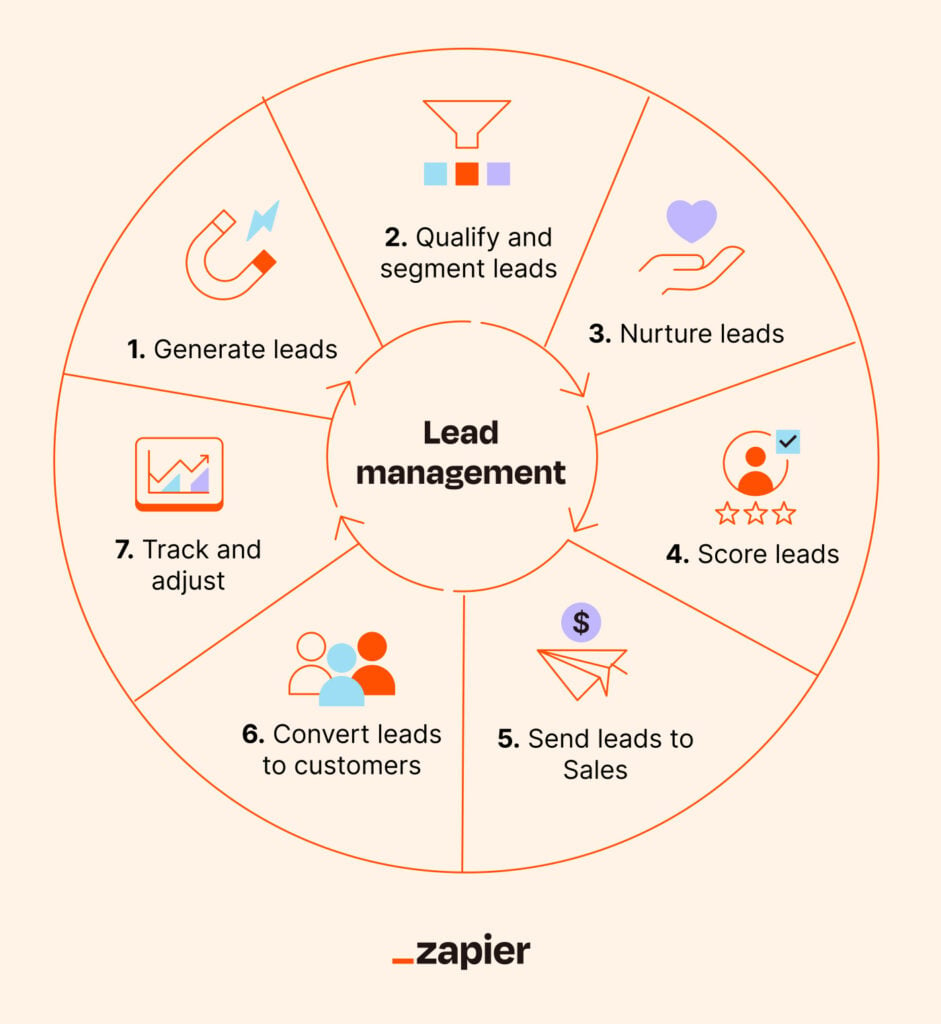The Art of Lead Management: Lead management strategically guides potential customers through their buying journey, ensuring efficient service like a well-run restaurant, enhancing customer engagement and satisfaction.
Boost Your Conversion Rates: Implementing effective lead management alongside marketing automation can significantly increase lead generation and conversion rates, demonstrating the impact of a solid strategy on business outcomes.
Focus on What Matters: A robust lead management process helps sales teams concentrate on high-potential leads, preventing opportunities from being overlooked and ensuring maximum efficiency in the sales pipeline.
Lead Management as a Flywheel: Viewing lead management as a continuous flywheel emphasizes the ongoing process of generating, nurturing, converting, and tracking leads, leading to sustained business growth.
Lead management means actively shaping and guiding the buyer’s journey until they're ready to become customers. But without a strategic plan in place, it’s like running a restaurant where no one knows which tables need service—chaotic and inefficient.
A solid lead management process can change everything. According to Invesp, businesses that pair effective lead management with marketing automation see an 80% boost in lead generation and conversion rates.
Whether you're a RevOps manager or a revenue leader, these six steps will give you the roadmap to build a sales pipeline that converts.
What is Lead Management?
Lead management is the process of capturing, tracking, and nurturing potential customers until they’re ready for sales engagement.
Think of it like running a pizza restaurant. Your goal isn’t to serve everyone but to guide the right people—the ones craving what you have to offer—through your lead funnel from initial interest to conversion.
When done right, lead management keeps leads from slipping through the cracks and helps your sales team focus on the opportunities that matter.

The flow of the lead management process typically looks like this:
- Identification: Forms and analytic tools integrated within your website and other channels collect lead information.
- Tracking: Your CRM software or lead management tool monitors how they behave on your website. Such as pages they visit, click-through rates, and other engagement metrics.
- Qualification: Using lead scoring, you'll rank and compare which potential buyers are more likely to become customers. These are your qualified leads, and they are ready for the sales process.
- Nurturing: Here, marketing leads who aren't sales-ready rather than letting them go. They'll use email campaigns and other tactics to engage with them and address pain points.
- Conversion: The marketing team hands over the right leads to the salespeople, where they'll receive personalized treatments and follow-ups.
6 Steps for an Effective Lead Management Process
1. Lead Generation
Start with a clear understanding of your audience and how to reach them. Lead generation sources cover everything from SEO and digital ads to referrals and social media. Depending on your strategy, you might focus on:
- SEO: Optimize your site for relevant keywords and aim to rank higher on Google. Remember, users trust organic results—they click on them 73% of the time.
- Content Marketing: Create valuable content like blog posts, ebooks, and webinars to attract leads. Think about using gated content like case studies to collect contact info.
- Digital Advertising: Leverage platforms like Google, Facebook, or YouTube to run ads that target your audience based on demographics, behaviors, and preferences.
When you’re generating leads through diverse channels, you’re setting up a continuous flow of opportunities to fill your sales funnel.
| Lead Generation Channel | Example Tactics |
| SEO (Search Engine Optimization) | Optimize website content with keywords, build backlinks, and improve site speed. |
| Digital Advertising | Run targeted ads on platforms like Google, Facebook, and YouTube. Leverage retargeting for warm audiences. |
| Content Marketing | Create valuable content such as blog posts, ebooks, webinars, and case studies. Use gated content to collect leads. |
| Social Media | Engage with audiences through organic posts and paid ads. Collect leads through sign-ups, promotions, and interactive content. |
| Referral Programs | Encourage current customers to refer others. Offer incentives like discounts or rewards for successful referrals. |
2. Lead Scoring
Lead scoring helps you separate high-quality leads from tire kickers. Assign scores based on firmographic data and behavior, like whether a lead requested a demo or downloaded an ebook.
The key is to keep iterating on your lead scoring model. It's not a one-and-done kind of deal. Use feedback loops between marketing and sales to fine-tune your scoring criteria.
3. Lead Nurturing
Not every lead is ready to convert right away. Nurturing is about engaging leads with valuable content, helping them see how your solution fits their needs. Here’s how to do it:
- Personalized Outreach: Use data to craft personalized emails. It’s not just a nice-to-have—it’s essential. Personalized emails have an open rate of 36%. Call your leads by name, reference their company, and address specific pain points.
- Content Segmentation: Divide your leads into segments based on behavior and interests. That way, your content feels more relevant to each lead.
Consider creating multiple email campaigns for each funnel stage to provide tailored messaging that encourages engagement.
4. Lead Distribution and Routing
Timing is everything. Automated lead routing gets sales-ready leads into the right hands as soon as they reach a conversion point. You can set up triggers to automatically assign leads to sales reps based on specific criteria like job function, expertise, or even region.
Before choosing a lead routing software, make sure it integrates smoothly with your CRM and marketing tools. For example, platforms like HubSpot and Freshsales offer automation rules that streamline lead distribution.
5. Tracking and Measuring Leads
You can’t improve what you don’t measure. Tracking key lead metrics helps you spot patterns and refine your strategy over time. Here are a few critical metrics to keep an eye on:
- Conversion Rate: How many leads actually become paying customers?
- Lead Source: Which channels bring in the most valuable leads?
- Customer Acquisition Cost (CAC): Calculate the cost of acquiring each lead, including marketing and sales expenses.
Use advanced tracking tools to continuously monitor your lead flow and conversion patterns. This way, you’ll know where to double down and where to pivot.
If you aren't ready to make the software leap, a prospect tracking spreadsheet can help you manage data manually.
6. Follow Up
Re-engaging old leads is a missed opportunity for many companies. Segment these leads based on their previous interactions and use tailored follow-up strategies. For instance, an extended nurture campaign with additional touchpoints could rekindle interest in leads that went cold.
Benefits of a Strong Lead Management Process
Today’s teams are leaner than ever, which means efficiency is the key to productivity. A well-defined lead management process results in:
Efficiency in Resource Allocation
When your team knows where to focus, you’re not wasting resources chasing unqualified leads. A streamlined lead management process helps prioritize leads and automate routine tasks, allowing your team to focus on what matters most.
Adaptation to Market Disruptions
With lead management, you’re also collecting valuable insights about customer behavior. If market trends shift, having the right data lets you make proactive decisions. During downturns, you can focus on high-value segments to maintain revenue stability.
Revenue Increase
Ultimately, a well-defined process results in higher conversion rates and increased revenue. Companies with optimized lead management systems report a 133% increase in revenue growth compared to their competitors.
Lead the Way
Lead management isn’t just a buzzword—it’s a necessity for scaling SaaS companies. By actively refining your lead management process, you’ll keep your sales team productive, your funnel full, and your conversion rates climbing.
Want to take your RevOps game to the next level? The RevOps Team is launching a newsletter soon. Sign up to get career resources, software reviews, and advice from RevOps experts delivered to your inbox.


